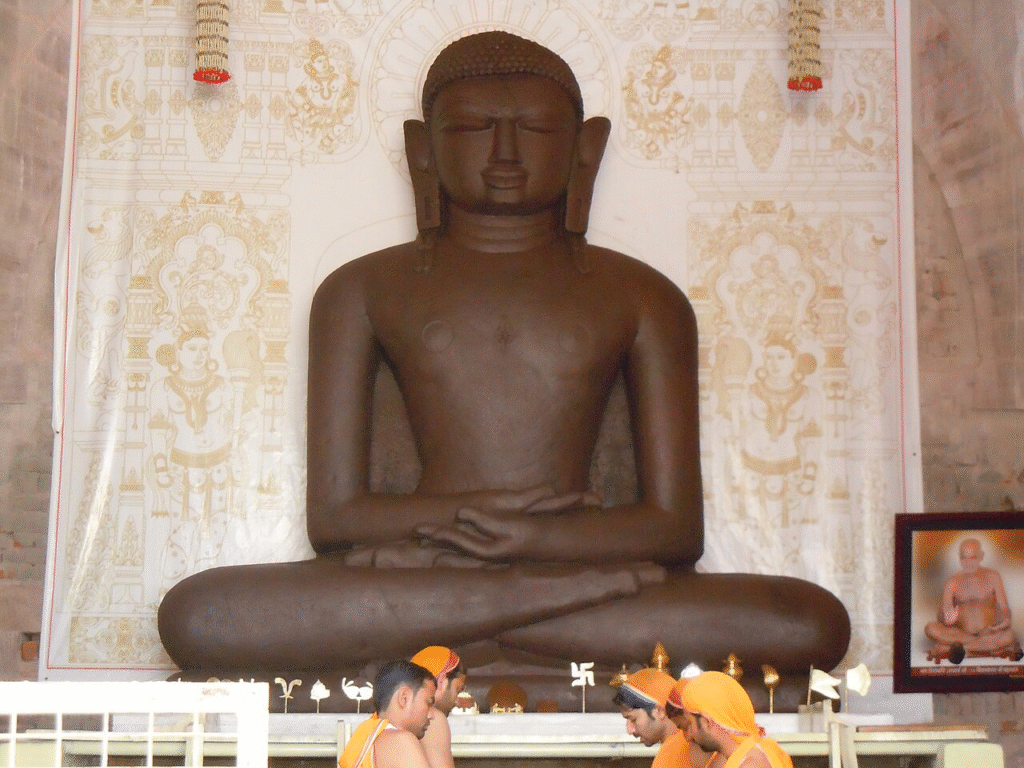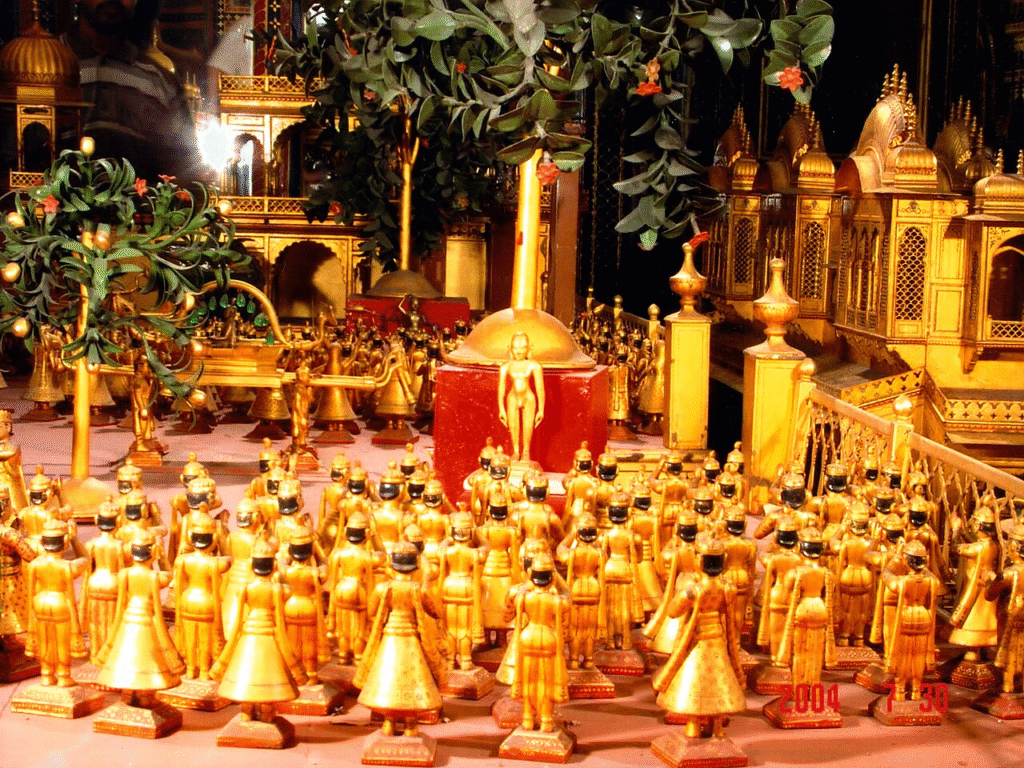
Adinatha at Kundalpur
In the timeless tapestry of Indian spiritual thought, the Jain tradition holds a revered space — ancient, non-violent, and profoundly introspective. At the very heart of this tradition stands the first Tirthankara: Lord Rishabhanatha, also known as Adinath, the founder of Jain Dharma in the current time cycle (Avasarpini).
Let us explore the life, significance, teachings, and symbolism of Rishabhanatha, the Adi Guru, who laid the foundation for one of the world’s oldest philosophies of peace and renunciation.
📜 Who is a Tirthankara?
In Jainism, a Tirthankara is not a god in the creator sense but a liberated soul who attains Keval Jnana (infinite knowledge) and shows others the path to moksha (liberation). The word Tirthankara means “Ford-maker” — one who builds a spiritual bridge for others to cross the ocean of samsara (cycle of birth and death).
Jain cosmology speaks of 24 Tirthankaras in each time cycle. Rishabhanatha is the first of these enlightened beings in the current Avasarpini (descending half of time).
👑 Birth & Early Life of Rishabhanatha
- Parents: King Nabhiraja & Queen Marudevi
- Birthplace: Ayodhya, in the Ikshvaku dynasty
- Symbol: Bull (Nandi) — represents strength, patience, and simplicity
- Color: Golden
- Era: Rishabhanatha is believed to have lived millions of years ago, as per Jain time cosmology — in an age where humans were larger, lived longer, and had superior mental capabilities.

An idol of Rishabha with mother Marudevi at Palitana
✨ A Divine Birth
It is believed that Queen Marudevi saw 14 auspicious dreams before his birth, which indicated the arrival of a great soul. These dreams are common for the mothers of all 24 Tirthankaras.
According to Jain texts, at the moment of Rishabhanatha’s birth, the world experienced great harmony, reflecting his future role in establishing order and civilization.
🧠 The Founder of Human Civilization
Unlike other Tirthankaras who were spiritual reformers, Rishabhanatha was also a social innovator. He is said to have introduced:
- Farming & agriculture
- Pottery, cooking, and crafts
- Language, mathematics, music, and art
- Division of society into professions (varna system) — but based on merit, not birth
Thus, he is often revered as the first king, first teacher, and first spiritual master — a true Adi Purusha.
📚 His children included Bharata Chakravarti (after whom India is said to be named Bharat) and Bahubali, a celebrated spiritual hero in Jain lore.

Statuary representing meditation by Rishabhanatha in Kayotsarga posture. (Photo: Ajmer Jain temple)
🪔 Renunciation & Enlightenment
After ruling for thousands of years, Rishabhanatha realized the transient nature of material life. He renounced his kingdom and worldly attachments, becoming a Digambara monk (sky-clad, symbolizing total detachment).
🔇 13 Months of Silence
He observed deep silence (mauna) and severe penance, wandering as an ascetic without speaking, eating only what was offered spontaneously.
It is believed that only after 13 months, he received his first alms (Ikshu Ras — sugarcane juice) from King Shreyans, marking the origin of Jain rituals of alms-giving.
🧘 Attaining Keval Jnana
Through intense meditation and self-discipline, Rishabhanatha attained Keval Jnana (absolute knowledge) — becoming a Tirthankara. He then preached for many years, guiding thousands toward spiritual liberation.
📿 Core Teachings of Rishabhanatha
Though Jainism as a doctrine was systematized later, Rishabhanatha laid the foundational ethical and philosophical framework of Jain dharma:
| Principle | Meaning |
|---|---|
| 🕊️ Ahimsa | Non-violence in thought, word, and deed |
| 🛑 Satya | Commitment to truth |
| 🚫 Asteya | Not stealing or taking what is not freely given |
| 🔒 Brahmacharya | Celibacy and control over senses |
| 🧳 Aparigraha | Non-possession and detachment |
These Panch Mahavratas (Five Great Vows) later became the foundation for all Jain monks and householders alike.
🛕 Symbolism & Worship
- Main symbol: 🐂 Bull (represents strength, humility, grounding)
- Place of worship: Ayodhya, Mount Kailash (as per Jain texts)
- Famous temples:
- Shikharji (Jharkhand) – Nirvana Bhoomi
- Rishabhdev Temple, Rajasthan
- Shravanabelagola, Karnataka (for Bahubali, his son)
- Palitana, Gujarat

Footprints of Rishabhanatha at Hastinapur.
🌄 Nirvana (Liberation)
Rishabhanatha is believed to have attained moksha (liberation from the cycle of rebirth) on Mount Ashtapad (Kailash) after a long life of spiritual guidance and discipline. Jain cosmology describes this moment as divine, peaceful, and radiant — the soul becoming one with pure consciousness.
💬 Interesting Facts
- Jain scriptures like the Kalpa Sutra and Adipurana extensively detail his life.
- Rishabhanatha is sometimes mentioned in Hindu texts like the Bhagavata Purana, symbolizing the cultural overlap of spiritual traditions.
- He is called Adinath, meaning “the First Lord,” symbolizing his foundational role.
🙏 Final Thought
Lord Rishabhanatha’s life is more than just a spiritual tale — it is the beginning of humanity’s ethical consciousness. He shows us that:
Civilization is not just about progress, but about values.
Wisdom is not about words, but about living with awareness.
Lord Suvidhinatha (Pushpadanta): The 9th Tirthankara of Jainism
The One Who Conquered Through Purity and Discipline Among the 24 Tirthankaras of Jainism, Lord…
Lord Chandraprabha: The 8th Tirthankara of Jainism
The Moon-Glowing Liberator of Peace and Balance In the celestial lineage of the 24 Jain…
Lord Suparshvanatha: The 7th Tirthankara of Jainism
The Serene Protector with the Naga Canopy As we move forward in the divine lineage…
Lord Padmaprabha: The 6th Tirthankara of Jainism
In the divine lineage of the 24 Tirthankaras, Lord Padmaprabha — the 6th Tirthankara of…
Lord Sumatinatha: The 5th Tirthankara of Jainism
In the sacred journey of the 24 Tirthankaras, Lord Sumatinatha, the 5th Tirthankara of the…
Lord Abhinandananatha: The 4th Tirthankara of Jainism
As we continue to explore the divine lineage of the 24 Tirthankaras in Jainism, we…

